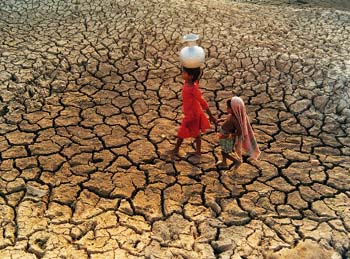Climate and Agriculture: How India Can 'Make it Rain'

With the rising temperatures contributing to the ongoing drought, India’s climate is far from pleasant. Rainfall has already been 44% below the average thus far into the monsoon season, and as El Nino approaches, weather forecasts have started indicating that a 7% rain deficit is a likely scenario; India will have a below-average monsoon season this year. To make matters worse, rising carbon emissions are contributing to the already unfortunate environmental conditions.
Considering how unfavorable current climate conditions are, its no wonder the annual agricultural output for this year looks less than promising. This is particularly devastating when considering the fact that Indian farmers will need to produce on average 50% more grain by 2020 to support the country’s rapidly growing population. India is known for its largely agriculturally based economy, and without access to adequate resources, such as water, the economy will undoubtedly suffer. The overall economic repercussions could cause permanent damage if the current declining trend of agricultural productivity continues.
One way to lessen the harsh results of weather-induced agriculture failure would be to assist rural farms in adopting different local farming methods. The Food and Agriculture Organization (FAO) is a sector of the UN dedicated to developing local sustainable-agriculture in various countries so that the general population—subsistence farmers, for example—can better adapt to changing climates. Adapting climactically appropriate models would result in better production yield and more cost-effective solutions for farmers who must endure harsh weather changes.
Presently, the Indian govt. has established the National Mission for Sustainable Agriculture (NMSA), one of the eight parts of the National Action Plan on Climate Change (NAPCC). NMSA has a mission similar to that of the FAO, which was set up to facilitate the transition between the ineffective status quo agricultural techniques and more appropriate future ones. Unfortunately, several holes still exist in the NMSA—without an explanation regarding how to implement its plans or how to distribute its technology, the mission clearly lacks a focused strategy.
Still, even without a detailed plan, the NMSA clearly reflects the areas in Indian agriculture that need the most repairs. If an organization could use the policies advocated by the NMSA to establish a project in India similar to a project conducted by the UN in another agriculture-heavy country, rural villages could learn how to change several currently ineffective crop-management techniques (irrigation, crop rotation, etc.) and instead adapt practices that are both more regionally suitable and more modern; the incorporation of biotechnology, for example, could potentially revolutionize the way small-farming is done in India. A locally organized approach designed to implement agricultural change could best combat the harsh ramifications of climate change.
Weather-based insurance has become a prominent resource that seems to effectively combat the repercussions of climate-damage; currently, many farmers in India receive financial security through this tool. In fact, to obtain farm-related loans in India, farmers are required to have agricultural insurance. Crop insurance allows farmers—both commercial and subsistence—to file claims and gain monetary assistance in the event of climatic instability. The Agriculture Insurance Company of India (AIC of India Ltd.) in particular provides insurance for various adverse weather conditions and damage done to several kinds of crops (including potatoes, coffee, and cardamom). One of the more advantageous elements of such insurance programs is a wider range of farmers receive access to agricultural security, consequently alleviating the damaging consequences of climate-related crop failure.
Until it can create more effective ways to manage the ongoing climate crisis, India’s agriculture industry will continue to endure damaging consequences. Adapting new methods of irrigation and farm-regulation could help mitigate these harms and instead result in a greater annual crop-yield, a larger number of insured farmers, and more overall security for the thousands of Indians who contribute to the economy through agricultural means.
[Image Attribute: AsiaNewsIT]



